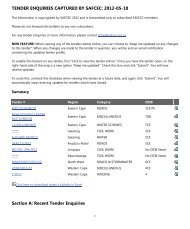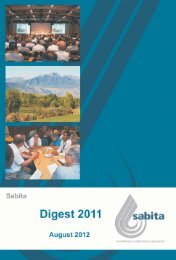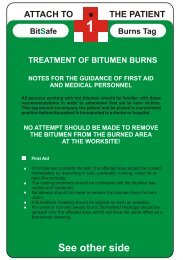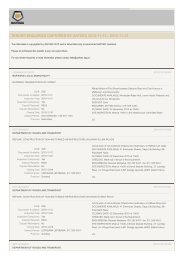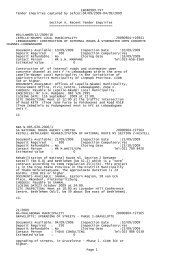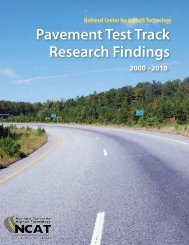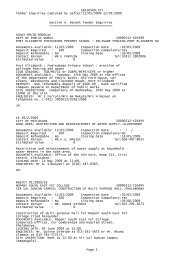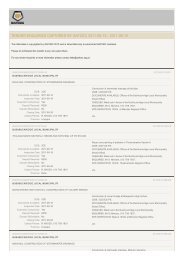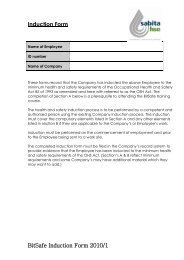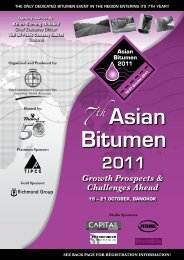DIGEST 2006 - Sabita
DIGEST 2006 - Sabita
DIGEST 2006 - Sabita
You also want an ePaper? Increase the reach of your titles
YUMPU automatically turns print PDFs into web optimized ePapers that Google loves.
operations, as well as to<br />
advance an understanding of<br />
the relationship between<br />
monotonic versus dynamic<br />
properties of cold mixtures;<br />
• Develop more realistic and<br />
reliable specimen preparation<br />
and conditioning protocols,<br />
especially with respect to<br />
compaction and curing.<br />
Cognisance needs to be taken<br />
of, for example, binder type,<br />
aggregate type and active<br />
filler content;<br />
• Identify a durability test for<br />
incorporation into the mix<br />
design procedure. In the<br />
broad sense, durability covers<br />
binder durability as well as<br />
mix durability (especially<br />
moisture damage). Current<br />
Tensile Strength Retained<br />
(TSR) tests in the ITS mode<br />
do not provide sufficiently<br />
reliable simulation of<br />
moisture damage;<br />
• Identify a reliable and robust<br />
classification system for<br />
emulsion and foamed<br />
bitumen treated materials<br />
that could be used for<br />
pavement design purposes.<br />
Although a unified system<br />
that would be generic for all<br />
cold mixes would be<br />
preferred, key differentiators<br />
may need to be incorporated<br />
to distinguish between the<br />
materials if this is not<br />
possible.<br />
Given the scope of these<br />
objectives, data on a wide range<br />
of mixes has already been<br />
gathered and synthesised in a<br />
database under several different<br />
headings, including mechanical<br />
testing (shear properties, resilient<br />
properties and permanent<br />
deformation), flexural testing<br />
(strain-at-break, flexural stiffness<br />
and fatigue), curing, durability<br />
(moisture susceptibility and binder<br />
ageing) and compaction.<br />
Laboratory and field research<br />
(using trial sections) will continue<br />
in 2007 to develop and calibrate<br />
revised and new procedures for<br />
the mix design of emulsion and<br />
foamed bitumen treated mixtures.<br />
Although some of the monitoring<br />
of field trials will continue through<br />
2008, by early in that year it is<br />
planned that sufficient findings will<br />
be available to incorporate into the<br />
new guideline.<br />
Structural design<br />
developments<br />
The aim of the structural design<br />
component of the project is to<br />
provide a practical, reliable and<br />
validated methodology for<br />
determining the structural capacity<br />
of pavements that incorporate<br />
bituminous stabilised layers. At<br />
the outset, it was recognised that<br />
such a method would require a<br />
significant knowledge base related<br />
to the construction and<br />
performance of pavements that<br />
incorporate BSM. A comprehensive<br />
search and analysis task is<br />
therefore being conducted to<br />
obtain and document data relating<br />
to the performance of BSM<br />
pavements under long term field<br />
loading conditions, as well as<br />
under Heavy Vehicle Simulator<br />
(HVS) testing.<br />
To date, the available construction<br />
and long term field performance<br />
information for 17 BSM pavement<br />
85



